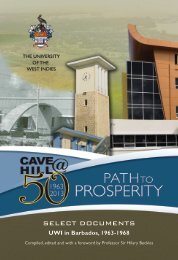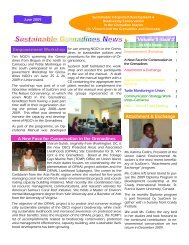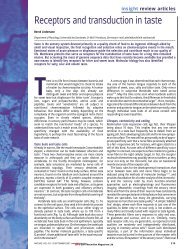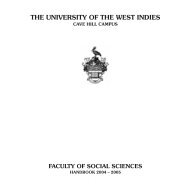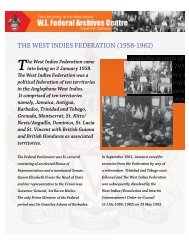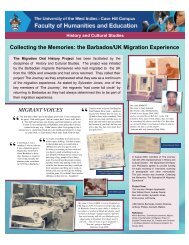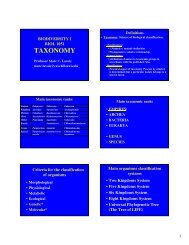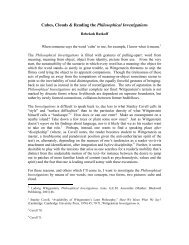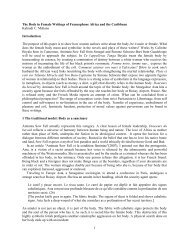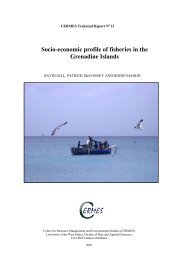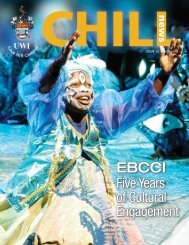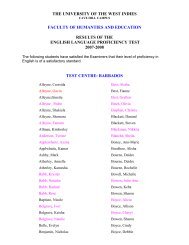THE SUSTAINABLE GRENADINES PROJECT - The University of ...
THE SUSTAINABLE GRENADINES PROJECT - The University of ...
THE SUSTAINABLE GRENADINES PROJECT - The University of ...
You also want an ePaper? Increase the reach of your titles
YUMPU automatically turns print PDFs into web optimized ePapers that Google loves.
Overing, J. 1997. Exploring the flora and fauna <strong>of</strong> Mustique. Prepared for <strong>The</strong> Mustique Company. 27 pp.<br />
This small guide to the island is by Julie Overing, who has highlighted it with many clear and colorful photos <strong>of</strong> the<br />
island’s flora and fauna. It was created to help visitors explore the attractions <strong>of</strong> Mustique and achieves this goal quite well,<br />
since it is very informative and easily read. It begins with a description <strong>of</strong> the island, its geography and climate. A brief<br />
description <strong>of</strong> the local reptiles, birds, cacti are provided, there is also a relatively large section on plants. It gives<br />
information on the various trails which includes ‘Watchable Wildlife’ and ‘Photo Opportunities’. <strong>The</strong> booklet concludes<br />
with a section titled ‘Preserving the Resources <strong>of</strong> Mustique’, a brief statement about the goals and role <strong>of</strong> the Mustique<br />
Company in protecting the environment. Several references are also provided which would be <strong>of</strong> interest to readers.<br />
Overing, J.A. 2004. Potential options for the protection <strong>of</strong> L’Ansecoy Bay beach. Report prepared for the Mustique<br />
Company.<br />
Not seen.<br />
Overing, J. and G. Cambers. 1995. Mustique environmental inventory. Volume 1: Report. Report prepared for <strong>The</strong><br />
Mustique Company. August 1995. 50 pp.*<br />
Mustique, a small private island in St. Vincent and the Grenadines, is renowned for its beauty, privacy and tranquillity.<br />
Now that the major residential development phase is nearing completion, the Mustique Company is concentrating on other<br />
aspects <strong>of</strong> development such as conservation and environmental management. <strong>The</strong> first stage <strong>of</strong> this strategy is to prepare<br />
an environmental inventory <strong>of</strong> Mustique. This present study which comprises two volumes (Volume 1: the report; Volume<br />
2: the appendices), presents an environmental audit <strong>of</strong> the island and its surroundings. Following a scientific description <strong>of</strong><br />
the island’s marine and terrestrial environment together with its flora and fauna, the report discusses the impacts <strong>of</strong><br />
development on Mustique’s environment. <strong>The</strong> major impacts include loss <strong>of</strong> wetlands; soil erosion and the loss <strong>of</strong> native<br />
vegetation; beach erosion, pollution; illegal hunting and anchor damage to coral reefs. <strong>The</strong>se problems are discussed and<br />
the ways to alleviate their future extent and impact are outlined. This inventory and the assessment provide the framework<br />
for a future environment management strategy for Mustique.<br />
Overing, J. and G. Chambers. 2004. 2004 update on environmental management in Mustique. Draft. November<br />
2004. 55 pp.*<br />
In 1995 a study was commissioned by the Mustique Company to prepare an environmental inventory <strong>of</strong> Mustique. <strong>The</strong><br />
purpose <strong>of</strong> that inventory was to prepare a quantitative baseline against which future changes could be measured and<br />
compared, and to make recommendations for mitigating impacts caused by development. In this 2004 report, the<br />
environmental inventory has been revisited to assess the changes that have occurred both environmentally and<br />
developmentally in nine years, to evaluate the progress that has been made with respect to the recommendations <strong>of</strong> the 1995<br />
report, to provide further direction and to address emerging issues that have arisen in this time. An index has been<br />
developed to assess the health <strong>of</strong> the environment and a report card has been created to evaluate how the island has faired.<br />
Based on these results, recommendations have been made to address the issues that arisen in the last nine years. <strong>The</strong><br />
recommendations provided to address these issues will assist the Mustique Company and the Environmental Committee in<br />
formulating an action plan to move forward for the next ten years to continue protecting and managing the valuable natural<br />
resources that make Mustique such a unique island.<br />
Oxenford, H. 1986. A Preliminary Population Survey <strong>of</strong> the West Indian Sea Egg (Tripneustes ventricosus) in St.<br />
Lucia, St. Vincent, Grenada and the Grenadines Islands. Ocean Research and Conservation association (ORCA)<br />
Inc. Victoria, B.C., Canada. Unpublished. 14 pp.*<br />
This 1986 report provided an approximate idea <strong>of</strong> the state and extent <strong>of</strong> sea egg populations in the island chain from St.<br />
Lucia to Grenada. <strong>The</strong> survey indicated the suitable study location for detailed population work in the future. Pages four to<br />
five provided the results gathered on the Grenadine Islands (Bequia, Canouan, Union Island and Rhonde Island).<br />
Paice, M.R. 2004a. <strong>The</strong> Cane Toad (Bufo marinus) on Mustique. Report prepared for the Mustique Company. 8 pp.<br />
Not seen.<br />
43



